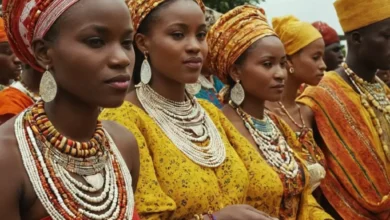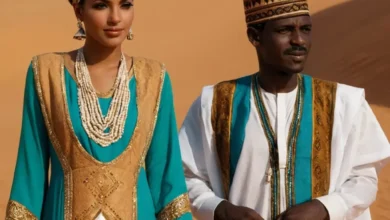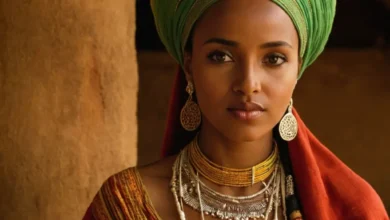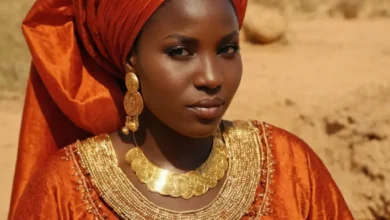South African Traditional Dress
South Africa, a land of breathtaking landscapes and vibrant cultures, boasts a rich tapestry of traditional attire that reflects its diverse heritage. From the colorful beadwork of the Xhosa to the elegant wraps of the Zulu, each ethnic group in South Africa possesses its own unique style of dress, steeped in symbolism, tradition, and artistry.
This article delves into the fascinating world of South African traditional dress, exploring its historical significance, cultural context, and contemporary relevance.
A Kaleidoscope of Colors and Patterns: The Significance of South African Traditional Dress
South African traditional dress is not simply clothing; it’s a powerful symbol of identity, history, and cultural expression. Each garment, each piece of adornment, tells a story, reflecting the customs, beliefs, and social structures of its people. Here’s a closer look at some of the key elements that make South African traditional attire so special:
Fabrics and Materials: A Connection to Nature
South African traditional dress often incorporates natural materials, drawing a strong connection between the people and their environment. Some of the most common fabrics include:
See also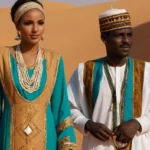 Sudanese Traditional Clothing: A Blend of Arab and African Influences
Sudanese Traditional Clothing: A Blend of Arab and African Influences
- Animal Skins: Historically, animal skins like cowhide and goat skin were widely used for garments, reflecting the importance of hunting and livestock in many cultures.
- Wool: Sheep wool, particularly from the indigenous merino breed, is woven into warm, durable fabrics like blankets and cloaks.
- Cotton: Cultivated in various regions, cotton provides lightweight and breathable fabrics for everyday wear.
- Silk: Though rarer, silk has been incorporated into some traditional attire, often reserved for special occasions.
Colors and Patterns: A Language of Symbolism
The vibrant colors and intricate patterns found in South African traditional dress are not merely decorative; they often carry deep symbolic meanings. Here are some common color associations:
- Red: Represents courage, strength, and vitality.
- White: Symbolizes purity, peace, and unity.
- Black: Often associated with mourning or spiritual power.
- Yellow: Represents the sun, prosperity, and wisdom.
- Green: Often symbolizes growth, fertility, and nature.
Patterns, too, hold significance. For example, geometric patterns may represent family lineages, while animal motifs symbolize specific virtues or beliefs. The intricate beadwork found in attire like the Xhosa’s indlamu (a colorful beaded skirt) showcases the skill and artistry of the craftspeople and reflects the intricate social structures of the community.
A Journey Through Diversity: Exploring Regional Styles
South Africa is home to 11 official languages and numerous cultural groups, each with its own unique style of traditional dress. Here’s a glimpse into some of the most prominent styles:
The Zulu: Grace and Elegance
The Zulu people, known for their rich cultural heritage and vibrant traditions, wear attire that emphasizes elegance and dignity. Some key elements include:
See also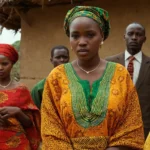 Tanzanian Traditional Clothing: From Kanga to Kitenge, Reflecting Cultural Identity
Tanzanian Traditional Clothing: From Kanga to Kitenge, Reflecting Cultural Identity
- Isicholo: A conical hat made of feathers, often worn by women as a symbol of status and beauty.
- Ibhulu: A patterned blanket made from wool, often worn by both men and women.
- Umqhele: A beaded headdress, signifying a woman’s marital status and social standing.
- Isidwaba: A woven skirt made from grass, typically worn by young girls.
Zulu traditional dress is often seen in vibrant colors like red, yellow, and green, with intricate beadwork and embroidery adding to its aesthetic appeal. The attire plays a vital role in ceremonies, rituals, and social gatherings, highlighting the importance of tradition and respect for elders.
The Xhosa: Bold and Beautiful
The Xhosa people, renowned for their rich oral traditions and vibrant artistic expressions, showcase a bold and distinctive style of traditional dress. Some key elements include:
- Indlamu: A colorful beaded skirt worn by women, often with intricate patterns reflecting the wearer’s social status.
- *Umtshatsha*: A beaded shawl worn by men, often symbolizing their courage and masculinity.
- Ibhulu: A blanket made from wool, often worn by both men and women, especially during colder months.
- Ukhamba: A traditional headdress made from feathers, often worn by men during ceremonies and rituals.
Xhosa traditional attire is known for its vibrant colors, particularly red, black, and white, and its use of beadwork, which requires meticulous craftsmanship and skill. The attire is an integral part of Xhosa cultural celebrations, including weddings, funerals, and traditional ceremonies, signifying the wearer’s lineage, status, and cultural pride.
The Ndebele: Geometric Mastery
The Ndebele people, known for their vibrant art and intricate beadwork, showcase a unique style of traditional dress that emphasizes geometric patterns and bold colors. Key elements include:
- Isigqoko: A beaded headdress worn by women, often incorporating intricate geometric patterns.
- Isicholo: A conical hat made of feathers, often adorned with beads and feathers.
- Umbhaco: A brightly colored wrap, often worn by women as a symbol of their status and elegance.
Ndebele traditional dress is characterized by its use of bold colors like red, yellow, blue, and green, often arranged in geometric patterns. The beadwork is particularly intricate, showcasing the artistry and cultural significance of the Ndebele people. The attire serves as a powerful symbol of Ndebele identity, cultural pride, and their connection to the land and ancestors.
From Tradition to Modernity: The Contemporary Relevance of South African Traditional Dress
While traditional dress holds deep cultural significance, it is also evolving and adapting to the modern world. Young South Africans are increasingly embracing their cultural heritage through contemporary interpretations of traditional clothing, showcasing its relevance in today’s diverse and globalized world.
Fashion Designers: Weaving Tradition into Modernity
South African fashion designers are playing a vital role in promoting and reinterpreting traditional dress, creating contemporary designs that resonate with both local and international audiences.
They incorporate traditional elements like colors, patterns, and materials into modern silhouettes, creating unique and stylish garments that celebrate South African heritage while maintaining a contemporary aesthetic.
These designs often use traditional fabrics like Shweshwe, a vibrantly colored printed cotton fabric, or amakhuba, a woven blanket made from wool.
Celebrities and Public Figures: Raising Awareness
Celebrities and public figures are increasingly embracing traditional South African attire, raising awareness of its beauty and cultural significance. From attending international events in traditional garments to promoting local designers, they are playing a significant role in showcasing the diversity and artistry of South African fashion. This visibility helps to challenge stereotypes and celebrate the richness and beauty of South African culture.
Cultural Events and Festivals: A Celebration of Heritage
South African cultural events and festivals provide platforms for showcasing traditional dress and celebrating the country’s diverse heritage. From the annual National Arts Festival in Grahamstown to local festivals like the Soweto Gospel Choir Festival, these events offer a vibrant tapestry of music, dance, and fashion, showcasing the beauty and diversity of South African culture. They also provide opportunities for young people to learn about their heritage and connect with their roots.
FAQs about South African Traditional Dress
What is the significance of beadwork in South African traditional dress?
Beadwork is a significant element in many South African cultures, representing the artistry and skill of the craftspeople. It often symbolizes social status, lineage, and cultural identity. The intricate patterns and colors used in beadwork tell stories, convey messages, and reflect the richness of South African traditions.
What is the difference between Shweshwe and amakhuba?
Shweshwe is a printed cotton fabric known for its vibrant colors and intricate patterns. It originated in the 19th century and is now widely used for clothing and accessories in South Africa. Amakhuba is a woven blanket made from wool, traditionally used for warmth and protection.
It often features intricate patterns and colors specific to different ethnic groups. Both fabrics represent important aspects of South African cultural heritage and are incorporated into contemporary fashion designs.
How can I learn more about South African traditional dress?
There are numerous resources available to learn more about South African traditional dress, including books, museums, cultural events, and online platforms. Museums like the South African Museum in Cape Town and the Apartheid Museum in Johannesburg offer exhibits showcasing traditional attire from different ethnic groups.
Cultural events and festivals are also great opportunities to experience traditional dress firsthand and learn about its cultural significance.
Conclusion: A Legacy of Beauty and Cultural Pride
South African traditional dress is a vibrant testament to the rich cultural heritage of the country. From the intricate beadwork of the Xhosa to the elegant wraps of the Zulu, each garment reflects the unique traditions, beliefs, and artistry of its people.
While rooted in history and tradition, South African traditional dress is also evolving and adapting to the modern world, showcasing its enduring relevance in a globalized society. By embracing and celebrating traditional attire, South Africans continue to honor their heritage and showcase the beauty and diversity of their vibrant culture to the world.
